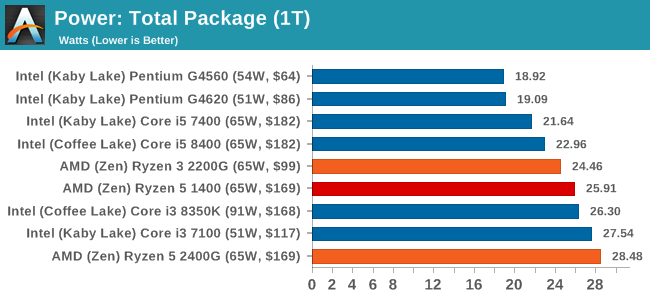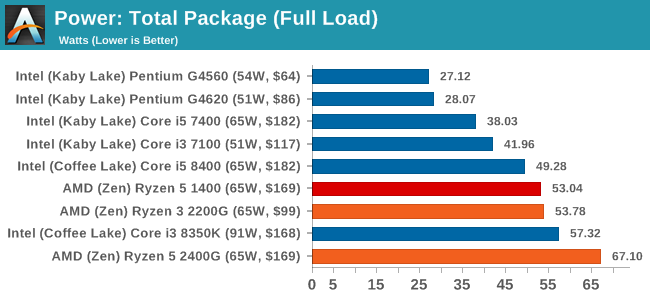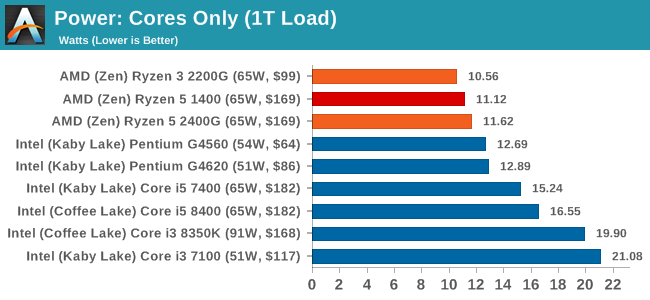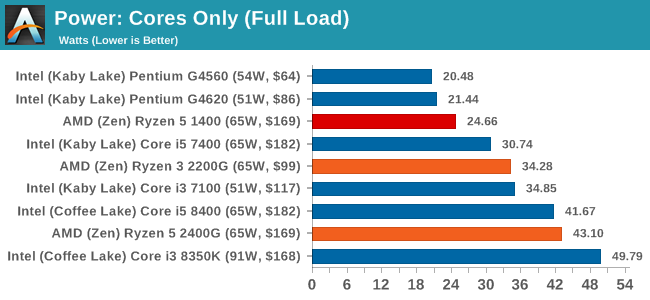Marrying Vega and Zen: The AMD Ryzen 5 2400G Review
by Ian Cutress on February 12, 2018 9:00 AM ESTPower Consumption
For our power consumption metrics, we use a Prime 95 blend on fixed threads to generate a strong load, and then poll the internal power registers that determine power state calculations to get the power consumption. Each processor is different in how it reports its power, which depends on the level of control the processor has: some of the more advanced CPUs, such as Ryzen, will provide per-core power numbers, while the latest Intel CPUs only give a figure for the CPUs as a whole but also include DRAM controller and uncore power consumption.
An interesting element to the power consumption on the Ryzen APUs, due to the unified power delivery subsystem in play feeding the CPU and the integrated graphics, is that the power registers only report half the power consumption when probed (e.g. when 14W, shows 7W). As of yet, we are unsure if this has a knock-on effect on how the processor adjusts its turbo modes in response to power consumption. Nonetheless, a simple scaling factor gives the following results.
Total Package: The Whole Processor
For this data, we take the values of the processor as a whole, which includes all the interconnect, memory controllers, PCIe root complexes, etc. The system is still only loading the CPU cores with minimal effect on the rest of the system, however depending on how the power is managed, some of the sub-systems still remain enabled.


At full load, the difference between the Ryzen 5 and the other Ryzen CPUs shows that the 2400G is using more of its upper margin, compared to the 1400 which is rated at the same power (note TDP is only determined at the base frequency), but the extra frequency of the 2400G means that there is extra power draw overall. Part of this is due to the Infinity Fabric, which we will see below. But what these tests also underline is that in a quad-core configuration, the Intel CPUs are still very power efficient.
Cores Only: Pure Work
For the processors that split out the data, we can look at the power consumption of the cores on their own, without any of the sub-systems, like uncore, mesh, or infinity fabric. This usually paints a different picture to the package power.


For the core only power, the Ryzen 5 2400G uses less power than the Core i3-8350K, despite the situation being reversed when considering the whole package. This means that Infinity Fabric takes a lot of power here, and the ring bus solution that Intel uses benefits from being simpler, and Intel can push more power to its individual cores.










177 Comments
View All Comments
speely - Monday, February 12, 2018 - link
"Where is the i5-8400 that has the same price as the 2400G?Oh, yeah, they totally left it out from the benchmarks since it would have proved an absolute supremacy of the Intel offering.
Ops."
In which benchmarks do you expect to see the i5-8400 prove its "absolute supremacy" where the i5-7400 didn't? Seriously, I'd like to know.
Because what I see is either the i5-7400 beating the 2400G or going punch to punch with it, or being thoroughly decimated by it.
If the i5-7400 beats or competes with the 2400G, the i5-8400 refresh chip will do the same. If the i5-7400 gets trounced by the 2400G, the i5-8400 refresh chip isn't suddenly and magically going to beat it.
I fail to see anything in the article to indicate a pro-AMD bias on AT's part, either intentional or unintentional.
What I do see is a fanboy who's upset to see his team losing some benchmarks.
Kamgusta - Monday, February 12, 2018 - link
Ehm sir, 7400 is 4 core and 8400 is 6 core.Other reviews shows a 30% performance dominance of i5-8400 over the 2400G.
speely - Monday, February 12, 2018 - link
Fair point, and my apologies. I keep forgetting that they upped the i5's to 6 cores after a decade of 4c4t i5's (including the 4690K I currently use).That being said, the i5-8400 itself is the same price as the 2400G, but getting the i5-8400 running is not the same price as getting the 2400G running. The 2400G was tested on an MSI B350I Pro AC (https://www.anandtech.com/show/12227/msi-releases-... which is new and doesn't yet have a publicly-known MSRP, but is built and featured like other $70-80 B350 motherboards. What motherboards are on the market today for $70-80 that support the i5-8400?
So we've taken into account the additional 2 cores and the subsequent boost to the CPU-focused benchmarks, which the 7400 sometimes lost and sometimes won against the 2400G, and put a couple small notches into the 8400's belt. For another 50 bucks or so on the motherboard just to use the 8400, that's not too bad I suppose. It's what I would expect pitting a 6c6t CPU against a 4c8t CPU in CPU benchmarks. It's certainly not "absolute supremacy" but it's something, right?
Were you expecting that "absolute supremacy" to show up in iGPU gaming? I'll just laugh about that and move on.
Sure, the 8400 could probably step past the 2400G in gaming and graphics if you paired it with a $120-or-so graphics card (assuming you can find one at $120 or so), but then you're comparing a dGPU to an iGPU and you're still only barely stepping past.
So the only real way to make the 8400 show "absolute supremacy" over the 2400G is to cherry-pick just the benchmarks you like, and bolster the 8400 with another $200 of additional hardware.
"Absolute supremacy".
Manch - Monday, February 12, 2018 - link
No it's not.In regards to vs the 8400, its a mixed bag. For programs that favor Intel CPU's there is a clear advantage. For programs that favor AMD the advantage swings the other way. For everything else that's generally proc agnostic they tie, pull ahead slightly or gets beat relatively evenly in regards to CPU performance.Now GPU wise, it gets crushed. That's obvious that is gonna happen.
If you plan on getting a DGPU with some beef, either is good, If you looking to game on the cheap, which is the target of the AMD proc in this review, its the hands down winner. Comparable perf, but with a beefier iGPU that can hang with a 1030. Also it gives you the option of adding a DGPU later when you need more grunt. It's clearly the better buy this go around. No other site that Ive seen has argued against this.
dromoxen - Tuesday, February 13, 2018 - link
Are these going to get a 12nm refresh , as all the other ryzen cpus? I am thinking of upgrade either i58400 or r5 1600/1700 or possibly 2400g.. decision decisions ...Manch - Wednesday, February 14, 2018 - link
Originally it was labeled as 12nm, now referred to 14nm+.Probably will be updated.cheshirster - Monday, February 12, 2018 - link
You need Z370 for the "supremacy" to work.Ops.
bug77 - Monday, February 12, 2018 - link
That will be fixed when lower tier 300-series chipsets launch. However, it's a significant problem for those wanting to build a cheap setup until then.Ian Cutress - Monday, February 12, 2018 - link
I used the chips I have on hand for the tests, forgot to add already tested chips - we haven't tested the i5-8400 IGP, but the CPU results are on hand in Bench. I can add those results to the graphs when I get a chance.Manch - Monday, February 12, 2018 - link
Ian, I dont know if fhis is just when browing from a phone but the bench when listing CPUs while alphabetic, bc of the chips names ~lake, etc. The listing jumps all over the place. 8 series before 4 seriez then 7 series. Can yall fix this? Thanks